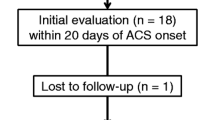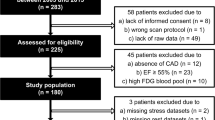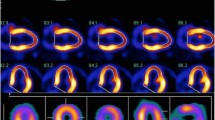Abstract.
We evaluated the efficacy of a new ischae-mia-avid imaging agent, technetium-99m labelled 4,9-diaza-3,3,10,10-tetramethyldodecan-2,11-dione dioxime (99mTc- HL91) as a marker of myocardial viability in ischaemic and reperfused myocardium. The left coronary artery of rats was ligated for 15 or 60 min and released. The myocardium was reperfused for 60 min [stunned myocardium, or acute myocardial infarction (MI)] or 7 days (subacute MI). Thereafter, 99mTc-HL91 and carbon-14 2-deoxyglucose (DG) were co-injected 30 min before sacrifice. We evaluated the myocardial accumulation of 99mTc-HL91 and DG by dual-tracer ex vivo autoradiography. The uptake of each tracer in the myocardial region was normalized by that in the septum (control), and expressed as percent uptake (%HL or %DG, respectively). Individual hearts were also histopathologically examined. The %HL in the stunned myocardium (n = 8) and in the septum were identical (101%±15%, mean±SD, P = ns), whereas the %DG was significantly increased (149%±27%, P<0.05) compared with that in the septum. These results suggest that 99mTc-HL91 cannot visualize stunned myocardium, whereas DG can. In acute MI (n = 7), the %HL (423%±96%, P<0.005) and the %DG (318%±91%, P<0.001) in the non-infarcted area at risk were significantly augmented compared with those in the septum. The %DG (181%±17%) in the infarcted area was also augmented (P<0.001), whereas the %HL (106%±25%) in the infarcted area was identical to that in the septum (P = ns). These results indicate that 99mTc-HL91 detected viable myocardium in the area at risk. In subacute MI (n = 8), the%HL in the infarcted area (101%±45%) and in the septum was identical, whereas %DG (292%±57%) was significantly higher than that in the non-infarcted risk area or the septum (P<0.0001). These findings suggest that DG detected viable myocardium in the area at risk, but that 99mTc-HL91 was not retained. We conclude that 99mTc-HL91 is a potent marker of myocardial viability when used during the early acute phase after reperfusion.
Similar content being viewed by others
Author information
Authors and Affiliations
Additional information
Received 9 September and in revised form 17 December 1997
Rights and permissions
About this article
Cite this article
Fukuchi, K., Kusuoka, H., Yutani, K. et al. Assessment of reperfused myocardium using a new ischaemia-avid imaging agent, technetium-99m HL91: comparison with myocardial glucose uptake. Eur J Nucl Med 25, 361–366 (1998). https://doi.org/10.1007/s002590050233
Issue Date:
DOI: https://doi.org/10.1007/s002590050233




